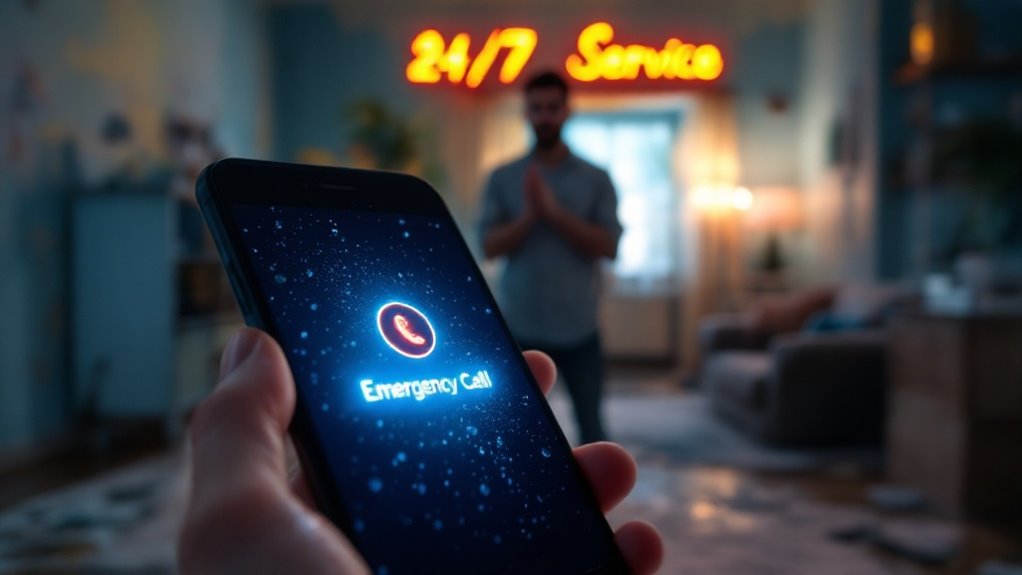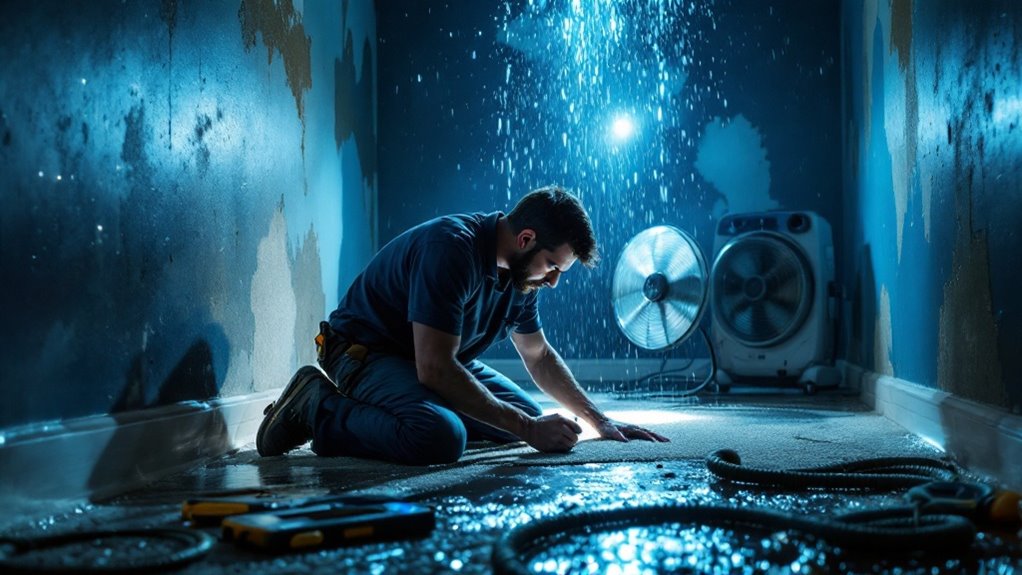When you call a 24/7 emergency water damage team, you might not realize how quickly they can mobilize to your crisis. The operator will ask specific questions to gauge the situation’s severity, ensuring a tailored response. Within just a couple of hours, a team can arrive, ready to tackle the problem head-on. But what exactly happens next? Understanding the process can make all the difference in restoring your property efficiently.
Key Takeaways
- You receive a quick response with clear communication, ensuring you know what to expect upon calling the emergency team.
- The team arrives within 1-2 hours, equipped to assess the situation and prioritize safety.
- They identify the water source and assess damage levels, including potential mold growth risks and structural integrity.
- Water extraction begins promptly using powerful pumps and vacuum units to minimize further damage.
- After drying and dehumidification, a comprehensive restoration plan is developed, addressing repairs and preventing future issues.
The Initial Call: What to Expect

When you make the initial call to an emergency water damage team, you can expect a quick response and clear communication. The operator will ask you crucial questions about the situation, like the source of the water and the extent of the damage. Don’t hesitate to provide as much detail as possible; it helps them assess the urgency. They’ll guide you on immediate steps to minimize damage, such as shutting off the water supply or moving valuables. You’ll likewise receive information about their arrival time and what to expect when they get there. This initial interaction sets the stage for effective service, ensuring they’re prepared to handle your emergency efficiently and professionally. Additionally, the team will utilize advanced technology to accurately assess the damage upon arrival.
Rapid Response: Arrival of the Emergency Team
In just a matter of minutes, the emergency water damage team will arrive at your location, ready to tackle the situation head-on. You’ll notice their professionalism as they step out of their vehicle, equipped with the tools and expertise needed to handle water damage effectively. They’ll quickly assess the scene, prioritizing safety while preparing to mitigate any further issues. You’ll appreciate their calm demeanor, as they communicate the steps they’ll take to address the problem. Expect them to ask questions about the source of the water and any visible damage. Their rapid response can greatly reduce the potential for long-term damage, so you can feel reassured knowing they’re on-site and ready to help restore your property to its former state. With their use of advanced technology for accurate evaluation, they ensure a thorough assessment of the damage right from the start.
Assessment of Damage: Evaluating the Situation

The emergency team quickly gets to work, evaluating the damage to your property with a keen eye for detail. They assess the extent of water intrusion and identify any potential hazards. By understanding the situation thoroughly, they can devise an effective plan for remediation. Here’s what they look for:
- Source of water: Determining whether it’s clean, gray, or black water.
- Affected areas: Identifying which rooms or materials have been impacted.
- Structural integrity: Checking for any compromised walls, floors, or ceilings.
- Mold risk: Evaluating conditions that could lead to mold growth.
- Safety concerns: Ensuring all areas are safe for both you and the team.
This careful assessment sets the stage for efficient recovery efforts. Additionally, their expertise in water damage restoration ensures that they can implement effective solutions tailored to your specific needs.
Water Extraction: Removing Excess Water
Once you’ve assessed the damage, it’s essential to start the water extraction process promptly. You’ll want to utilize specialized equipment to effectively remove excess water and prevent further issues. Understanding the right techniques can make all the difference in restoring your space efficiently.
Initial Assessment Process
As you assess the situation after water damage, prioritizing water extraction becomes crucial to minimizing further harm. This initial step helps prevent structural issues and mold growth. A thorough evaluation guarantees you understand the extent of the damage and the urgency of the situation.
- Identify the source of the water.
- Determine the affected areas and materials.
- Evaluate the level of water intrusion.
- Assess potential electrical hazards.
- Prioritize areas for immediate extraction.
Equipment Utilization Techniques
Effective water extraction relies on utilizing the right equipment to swiftly remove excess water and mitigate damage. When you call an emergency team, they’ll likely bring powerful pumps designed to handle large volumes of water. These pumps work quickly, ensuring that standing water is removed efficiently. Alongside pumps, vacuum units play a vital role for smaller spaces or leftover moisture, using suction to pull water from carpets and floors. Dehumidifiers will then be deployed to lower humidity levels, preventing mold growth. You’ll notice specialists using moisture meters to monitor the drying process, ensuring that all areas are thoroughly dried out. This combination of equipment and techniques is fundamental for restoring your property effectively and safely.
Drying and Dehumidification: Restoring Your Space

When water damage strikes, swift action is vital to prevent further destruction and restore your space. The drying and dehumidification process plays a key role in this restoration. You’ll want to guarantee that moisture is quickly and effectively removed to safeguard your property and health.
- Eliminate excess humidity to prevent mold growth.
- Use industrial fans and dehumidifiers for efficient drying.
- Monitor moisture levels with specialized equipment.
- Confirm proper ventilation throughout the affected area.
- Address hidden pockets of moisture behind walls and floors.
Final Inspection and Prevention: Ensuring Long-Term Solutions
After addressing the immediate water damage, it’s essential to conduct a thorough damage assessment to identify any lingering issues. You can implement preventative maintenance strategies to protect your space and minimize future risks. Long-term monitoring solutions will help you stay ahead of potential problems, ensuring your home remains safe and dry.
Comprehensive Damage Assessment
A thorough detailed damage assessment is crucial for identifying any lingering issues after water damage has occurred, ensuring you’re not left with hidden problems down the line. This process involves a careful examination of affected areas and materials, allowing professionals to pinpoint what needs immediate attention.
- Check for structural damage in walls and floors
- Assess moisture levels in hidden spaces
- Identify mold growth and potential health risks
- Inspect plumbing and electrical systems for safety
- Evaluate the effectiveness of previous repairs
Preventative Maintenance Strategies
While the damage assessment provides an essential understanding of the immediate issues at hand, implementing preventative maintenance strategies is vital for safeguarding your property against future water damage. Start by regularly inspecting your plumbing, checking for leaks or signs of wear. Clean gutters and downspouts to guarantee proper drainage, preventing water buildup around your foundation. Consider installing a sump pump in areas prone to flooding, and verify your appliances are in good working condition. Don’t forget to monitor your roof for damage or missing shingles, as these can lead to leaks. Finally, keep an eye on humidity levels inside your home; using a dehumidifier can help maintain a healthy environment and reduce moisture-related issues.
Long-Term Monitoring Solutions
Regular preventative maintenance lays the groundwork for effective long-term monitoring solutions. By implementing these strategies, you can guarantee your space remains safe and dry over time. Here are some key components to take into account:
- Routine inspections: Check for leaks and dampness regularly.
- Moisture detection systems: Install devices that alert you to water issues early.
- Climate control: Maintain ideal humidity levels to prevent mold growth.
- Professional assessments: Schedule annual evaluations with water damage experts.
- Emergency preparedness plans: Have a strategy ready for swift action if issues arise.
Conclusion
When you reach out to a 24/7 emergency water damage team, you’re not just getting timely help; you’re securing a swift solution to safeguard your space. From rapid response to meticulous methods, they tackle the turmoil with expertise. By ensuring effective extraction and diligent drying, they deter disaster and defeat mold. Trust these dedicated professionals to transform your troubles into triumph, bringing peace of mind back to your property and allowing you to breathe easy once again.
